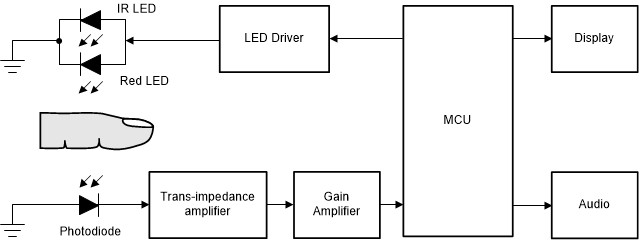SLAA897 June 2019 MSP430FR2353 , MSP430FR2355
1 Introduction
A pulse oximeter is a non-invasive device used to monitor the pulse rate and peripheral oxygen saturation (SpO2 %) of blood.
In principle, the oxygenated hemoglobin (HbO2) and de-oxygenated hemoglobin (Hb) respond differently to different wavelengths of light. De-oxygenated hemoglobin absorbs more red light compared to infrared (IR) light whereas oxygenated hemoglobin absorbs more infrared light. As Figure 1 shows, when Red and IR Light Emitting Diodes (LEDs) are driven alternately through a finger, the unabsorbed light received at the other end of the finger (where a photodiode is used as the sensing element) corresponds to the concentration of Hb and HbO2 in the blood.
The photodiode current is converted into a voltage signal by a Transimpedance amplifier (TIA). The amplified and filtered signal is sent to a microcontroller for further noise removal and calculations of SpO2 % and heart rate. For more details on the calculations, see A Single-Chip Pulsoximeter Design Using the MSP430.
 Figure 1. High-Level Block Diagram of a Pulse Oximeter (power supply not shown)
Figure 1. High-Level Block Diagram of a Pulse Oximeter (power supply not shown) The MSP430FR235x microcontroller enables full transmit and receive signal chain implementation with four integrated Smart Analog Combo (SAC) blocks on-chip. Each SAC includes a high-performance low-power operational amplifier (OA), a programmable gain amplifier (PGA) with gain up to 33V/V, and a 12-bit digital-to-analog converter (DAC). This configurable analog signal chain can be operated in various modes or can be cascaded together or connected with other peripherals as explained in How to Use the Smart Analog Combo in MSP430™ MCUs.
Some other important features of MSP430FR235x that can be used in a pulse oximeter application are:
- One 12-Channel 12-Bit Successive Approximation (SAR) ADC with precise internal references (1.5, 2.0, or 2.5 V)
- Ferroelectric RAM (FRAM) gives non-volatile storage comparable to Flash/EEPROM, with low power consumption and fast write access comparable to RAM.
- Multiple serial communication (Serial Peripheral Interface (SPI), Inter-Integrated Circuit (I2C), Universal Asynchronous Receiver/Transmitter (UART), IrDA) for interfacing with the display, buzzer, and so forth.
- An on-chip temperature sensor which can be used for temperature compensation of LED current strength and photodiode temperature drift.
- Two Enhanced Comparators (eCOMP) with integrated 6-bit DAC that can be used for wake-up detection and power voltage monitoring.